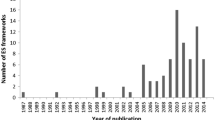Abstract
If we are going to protect ecosystems against adverse effects emanating from human activities, we need to be able to distinguish between what is “normal” and “abnormal” for them. By analogy with humans, this is increasingly referred to as ecosystem health. The analogy can be intended in a variety of ways: for example, that there is a direct similarity between the health states of humans and ecosystems (strong sense of the analogy); that there are sufficient similarities to justify drawing a parallel (weaker sense of the analogy); that there is a similarity in the way that medical practitioners and ecologists approach diagnosis and treatment. In terms of the general promulgation of environmental protection, the use of imagery drawing an analogy with the human condition is likely to have more impact than more abstract concepts.
Access this chapter
Tax calculation will be finalised at checkout
Purchases are for personal use only
Preview
Unable to display preview. Download preview PDF.
Similar content being viewed by others
References
Blanck H., Wangberg S-A., Molander S. (1988) Pollution-induced community tolerance - a new ecotoxicological tool. In Cairns J., Pratt J.R. (eds.) Functional Testing of Aquatic Biota for Estimating Hazards of Chemicals. ASTM-STP 988. American Society for Testing and Materials, Philadelphia pp:219–230
Bradshaw A.D., Hardwick K. (1989) Evolution and stress - genotypic and phenotypic components. Biological Journal of the Linnean Society 37: 137–155
Calow P. (1989) Proximate and ultimate responses to stress in biological systems. Biological Journal of the Linnean Society 37: 173–181
Calow P. (1991) Physiological costs of combating chemical toxicants; ecological implications. Comparativ Biochemistry and Physiology 100C: 3–6
Calow P. (1992) Can Ecosystems be healthy? Critical consideration of concepts. Journal of Aquatic Ecosystem Health 1: 1–5
Calow P. (1993) Ecosystems not optimised. Journal of Aquatic Ecosystem Health 2: 55
Costanza R., Norton B.G., Haskell B.D. (eds.) (1992) Ecosystem Health - New Goals for Environmental Management. Island Press, Washington D.C., California
Dawkins R. (1982) The Extended Phenotype. Freeman, London
Doi J. (1994) Complex mixtures. In Calow P. (ed.) Handbook of Ecotoxicology, Volume II. Blackwell Scientific Pubs., Oxford pp:289–310
Ehrenfeld D. (1992) Ecosystem health and ecological theories. In Costanza R., Norton B.G., Haskell B.D. (eds.) Ecosystem Health - New Goals for Environmental Management. Island Press, Washington D.C., California pp: 135–143
Haskell B.D., Norton B.G., Costanza R. (1992) Introduction: What is ecosystem health and why should we worry about it? In Costanza R., Norton B.G., Haskell B.D. (eds.) Ecosystem Health - New Goals for Environmental Management. Island Press, Washington D.C., California pp: 1–19
Horn H.S. (1981) Succession. In May R.M. (ed.) Theoretical Ecology (2nd Ed). Blackwell Scientific Pubs., Oxford pp:253–271
Karr J.R. (1991) Biological integrity: a long-neglected aspect of water resource management. Ecological Applications 1: 66–84
Lawton J.H. (1989) Food webs. In Cherrett J.M. (ed.) Ecological Concepts. B.E.S. Symp. Blackwell Scientific Pubs., Oxford pp:43–78
May R.M. (1981) Patterns in multi-species communities. In May R.M. (ed.) Theoretical Ecology ( 2nd Ed ). Blackwell Scientific Pubs., Oxford pp: 197–227
Maynard Smith J. (1984) The population as a unit of selection. In Shorrocks B. (ed.) Evolutionary Ecology. Blackwell Scientific Pubs., Oxford pp: 193–202
Menzel D.M. (1977) Summary of experimental results: controlled ecosystem pollution experiment. Bulletin of Marine Science 27: 1–7
Odum E.P. (1985) Trends expressed in stressed ecosystems. Bioscience 35: 419–422
O’Neill R.V., De Angelis D.L., Waide J.B., Allen, T.F.H. (1986). A Hierarchical Concept of Ecosystems. Monographs in Population Biology 23. Princeton University Press, Princeton, New Jersey
Pearce D. (1993) Economic Values and the Natural World. Earthscan Pubs. Ltd., London
Pimm S.L. (1982) Food Webs. Chapman and Hall, London
Rapport D.J. (1989) Symptoms of pathology in the Gulf of Bothnia (Baltic Sea): Ecosystem response to stress from human activity. Biological Journal of the Linnean Society 37: 33–49
Rapport D.J. (1992) What is clinical ecology? In Costanza R., Norton B.G., Haskell B.D. (eds.) Ecosystem Health - New Goals for Environmental Management. Island Press, Washington D.C., California pp: 144–156
Schindler D.W. (1987) Detecting ecosystem responses to anthropogenic stress. Canadian Journal of Aquatic Sciences 44 (Suppl. l): 6–25
Suter G.W. (1993) A critique of ecosystems health concepts and indexes. Environmental Toxicology and Chemistry 12: 1533–1539
Townsend C.R. (1989) The patch dynamics concept of stream community ecology. Journal of the North American Benthological Society 8: 36–50
Westman W.E. (1977) How much are nature’s services worth? Science 197: 960–964
Williams G.C. (1992) GALA, nature worship and biocentric fallacies. The Quarterly Review of Biology 67: 479–494
Wright J.F., Armitage P.D., Furse M.T., Moss D. (1989) Prediction of invertebrate communities using stream measurements. Regulated Rivers: Research and Management 4: 479–494
Yodzis P. (1986) Competition, mortality and community structure. In Diamond J.M., Case J.J. (eds.) Community Ecology. Harper and Row, New York pp:480–491
Author information
Authors and Affiliations
Editor information
Editors and Affiliations
Rights and permissions
Copyright information
© 1995 Springer-Verlag Berlin Heidelberg
About this paper
Cite this paper
Calow, P. (1995). Ecosystem Health — A Critical Analysis of Concepts. In: Rapport, D.J., Gaudet, C.L., Calow, P. (eds) Evaluating and Monitoring the Health of Large-Scale Ecosystems. NATO ASI Series, vol 28. Springer, Berlin, Heidelberg. https://doi.org/10.1007/978-3-642-79464-3_2
Download citation
DOI: https://doi.org/10.1007/978-3-642-79464-3_2
Publisher Name: Springer, Berlin, Heidelberg
Print ISBN: 978-3-642-79466-7
Online ISBN: 978-3-642-79464-3
eBook Packages: Springer Book Archive




